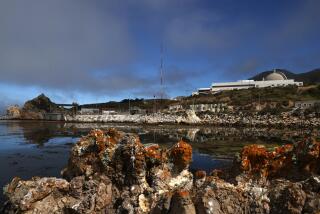Power Is on the Line
- Share via
Talk about a power struggle.
As an economic recovery spurs demand for electricity and California prepares for another summer that could overtax transmission lines, a plan that would make way for construction of the San Diego area’s first new power plants in 20 years is in trouble.
The five-member California Public Utilities Commission is scheduled to vote in San Francisco today on a proposal by San Diego Gas & Electric Co. to dramatically expand the amount of power available to its 3 million customers in San Diego and southern Orange counties.
Consumer activists are vowing to fight the plan in court if it’s approved with a “yes” vote by PUC President Michael Peevey. They contend that Peevey is biased because he helped SDG&E; put the deal together. A lawsuit could make it tough for the utility and independent power producers to persuade Wall Street to lend them the hundreds of millions of dollars needed to build the plants.
The consumer groups -- and at least two commissioners -- are also concerned that the deal could saddle SDG&E;’s ratepayers with more electricity than they could use and higher utility bills.
Most players in California’s post-crisis energy game agree on the need for a well-supplied electricity market that can quickly respond to peak demands in the state. But the consumer activists aren’t about to hand SDG&E; what they view as a blank check.
“It’s overkill,” said Matt Freedman, an attorney with the Utility Reform Network, a San Francisco-based consumer group known as TURN.
Freedman contends that SDG&E;, which originally said it had a short-term power shortage of 300 megawatts, wants to increase its supply of electricity by 1,200 megawatts -- enough to power about 1.2 million homes.
“The rush to get this deal done could cost San Diego ratepayers,” Freedman said. “There’s a mantra of ‘action, action, action.’ ”
Under its proposal, SDG&E;, a subsidiary of Sempra Energy, would purchase the unfinished gas-fired Palomar plant in Escondido and would contract with independent power generator Calpine Corp. to acquire a similar amount of power from another state-of-the-art power plant now being built at Otay Mesa east of San Diego.
Work on both plants has been stalled as financial support of power projects has waned.
Peevey and the utility contend that increasing the capacity of the electricity grid is crucial to avoiding a repeat of the energy crisis of 2000-01, which caused rolling blackouts across the state. Completing construction of the two power plants also is part of the commission’s effort to bolster electricity reserves across Southern California.
“This is an example of whether we as a regulatory body are willing to step up to our responsibility and help ensure that the electricity needs in San Diego and, ultimately, in all California are met in a timely manner,” said Peevey, who acknowledges that he played a role in putting the San Diego proposal on a fast track through the usually deliberate PUC.
The process began late last year when the PUC, in another controversial decision, approved a bid by Rosemead-based Edison International to buy another stalled power plant -- the unfinished Mountainview facility in Redlands -- and sell the power to its regulated utility, Southern California Edison.
For the PUC, both the pending SDG&E; decision and the Mountainview approval present a first opportunity to begin restructuring California’s energy market after the failure of the 1996 deregulation law.
The commission is promoting a hybrid strategy that encourages investor-owned utilities like SDG&E; to build their own plants while signing long-term electricity contracts with non-utility, independent power producers like San Jose-based Calpine.
The dual-track approach mirrors Gov. Arnold Schwarzenegger’s recent request that the commission move quickly to implement a new state law that pushes utilities to avoid power shortages and price spikes by entering into long-term contracts with power producers.
The governor, though he has taken no position on the SDG&E; matter, has urged the commission to create “a transparent, competitive” wholesale electricity market.
Critics, however, question both the transparency and the competitiveness of SDG&E;’s plan. They worry that the purchase of the 550-megawatt Palomar plant from the utility’s non-regulated affiliate, Sempra Energy Resources, could be self-serving.
They also contend that the utility, with Peevey’s support, tilted its power contract negotiations in favor of Calpine’s 570-megawatt Otay Mesa plant and against offers from competing independent generators.
“I’m not convinced that what was negotiated was the best financial deal for the ratepayers,” Commissioner Carl W. Wood said.
Another critical commissioner, Loretta Lynch, accused Peevey, SDG&E; and Calpine of trying to “jump the line” by rushing to approve the Palomar and Otay Mesa plants outside the panel’s normal review process for a utility’s long-term plan for providing electricity.
SDG&E;, however, says both plants are attractive because they are clean and efficient and have received all necessary siting and construction permits.
“This ensures that our customers will have the power they need. It’s that simple,” spokesman Ed Van Herik said.
Calpine spokesman Kent Robertson said his company’s negotiations with SDG&E; were open and competitive and resulted in a fair price for ratepayers. Both SDG&E; and Calpine denied they were pressured by Peevey or his staff to reach an agreement.
Peevey, a former top-ranking Edison executive from La Canada Flintridge, rejected the allegations of bias as baseless.
“We’re not just judges without any perspective. We can make our views known,” he said. “The bottom line is that anybody who is aware of what’s going on in this state knows there are serious and significant problems in terms of inadequate generation in San Diego County.”
Despite the support of Peevey, it’s unclear whether the SDG&E; plan has the votes it needs to pass, or whether the commission will even vote on the issue today. Commissioners Susan P. Kennedy and Geoffrey F. Brown have yet to weigh in on the matter.
If it does pass, consumer groups probably will face an “uphill battle” in persuading the state Court of Appeals to reverse the ruling on the ground that Peevey was bias in favor of SDG&E;’s proposal, said Severin Borenstein, director of the UC Energy Institute in Berkeley.
PUC members “are supposed to be involved in policy,” he said.
“They do get into cutting deals.”
More to Read
Inside the business of entertainment
The Wide Shot brings you news, analysis and insights on everything from streaming wars to production — and what it all means for the future.
You may occasionally receive promotional content from the Los Angeles Times.










